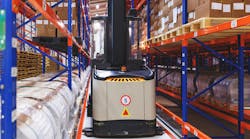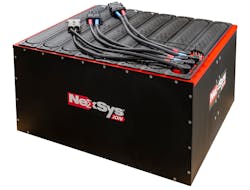Higher and Narrower: Managing Power Demands in the Warehouse
In recent years, warehousing has experienced a steady increase in operating and real estate costs, inventory volume, and the number of Stock Keeping Units (SKUs) processed. The increase in SKUs, which is the result of ever-increasing online shopping, has created a demand for greater selectivity in storage spaces. In cases where warehousing shares space with manufacturing, the manufacturing operations have been encroaching on the warehousing space, leading to an increased density of storage in the space that remains. In addition to space, warehouse operations are also facing increasing demands for a faster turnaround to meet customer expectations and to keep space available for new stock.
The U.S. Energy Information Administration reported a 26% increase in the number of buildings used for warehousing and storage from 2012 to 20181. Meanwhile, the size of the warehouses themselves have also grown. Coldwell Banker Richard Ellis (CBRE) Group, a commercial real estate services and investment firm, reported that e-commerce has driven a doubling of the footprint of warehouses constructed since the early 2000s. A comparison of the average size of warehouses constructed from 2002 to 2007 with those constructed from 2012 to 2017 revealed that not only did the average size increase by 143%, but the average clear height rose by 3.7 ft to a total of 32.3 ft2. In addition to a greater height, these demands have necessitated a greater capitalization of existing cubic space with narrower aisles. Standard-sized aisles are at least 12-ft-wide, but aisles are now also narrow at 6 to 12 ft in width, and very narrow at less than 6 ft in width.
In order to remain competitive as e-commerce becomes a more widespread means of distributing goods, a more extensive use of existing warehouse space has become necessary. Higher vertical stacking and narrower aisles, in both new and existing construction, have enabled more efficient use of storage space to accommodate increases in the number of SKUs and the speed of shipping, receiving, and picking. These changes have placed greater demands on material handling equipment, which has led to design innovations that better meet these demands.
In an effort to optimize the available space, warehouse storage systems are being designed to store product higher and with increasingly narrower aisles to improve the overall cube utilization. These changes have affected forklift design, especially on narrow and very narrow aisle trucks as well as order picker equipment. In order to accommodate higher storage spaces, especially for more slowly moving items that are light enough for safe overhead storage, these units are being constructed to reach heights of over 40 ft. Not too long ago, these levels of truck performance were considered difficult, if not impossible, to achieve. Today, they are becoming the blueprint for “green-field” operations and expansions in warehouse and distribution centers.
Learn more about NexSys iON batteries.
Like most material handling equipment, warehouse vehicles that navigate higher storage and narrower aisles are typically battery-powered. The increased demands for power being placed on these kinds of equipment have led to greater use of batteries with premium chemistries, such as Thin Plate Pure Lead (TPPL) and Lithium-ion (Li-ion). Compared with conventional flooded lead-acid batteries, these chemistries provide features that deliver greater reliability and reduce operating costs. Not only do they enable quicker and less frequent charging, but they also eliminate the need for maintenance of water levels and dedicated space for battery charging. This last feature allows that once “battery dedicated” space to be used for warehousing space.
Both TPPL and Li-ion batteries offer virtually maintenance-free operation: they do not require watering or long equalize charges, and while they often require an increased initial investment as compared to conventional lead-acid batteries, the low maintenance attributes enable TPPL and Li-ion batteries to offer a significantly lower Total Cost of Ownership (TCO). Their cycling capability enables both chemistries to provide the flexibility of opportunity charging during breaks, during lift truck downtime or at the end of shifts. Recent innovations in TPPL technology include the incorporation of a carbon additive into the battery’s chemistry, which increases the cycle life and the amount of energy produced. Innovations in Li-ion technology include the use of a Nickel Manganese Cobalt (NMC) chemistry that enables faster charging and greater recyclability.
Typically, light to medium-demand trucks use TPPL batteries and heavy-demand trucks use Li-ion. TPPL batteries typically cost less as an initial investment than Li-ion batteries and provide sufficient performance for light to medium-duty equipment, while the higher energy density of Li-ion batteries provides the performance needed for the heavier-duty equipment. In response to the evolving demands on warehouses, some operators are implementing a hybrid solution that utilizes both battery chemistries for different applications within the same warehouse to achieve optimal power performance. Both TPPL and Li-ion chemistries offer user-friendly options to cut operating expenses and minimize downtime while maintaining long-lasting productivity; which one you select depends on the power demands of the vehicle. Battery management software is also available to assist in this selection, which uses algorithms to analyze the number and size of the vehicles in the fleet, the number of shifts, specific power demands, and other factors which may contribute to a lower TCO.
Learn more about NexSys PURE batteries.
Burgeoning e-commerce requires warehouses to accommodate an increasing number of SKUs by putting more of their existing space to use through higher vertical storage and narrower aisles. As equipment designed to navigate these spaces has become available, the competitive environment that e-commerce has created necessitates more than ever that all material handling equipment operates efficiently and reliably. With faster and more flexible recharging, TPPL and Li-ion batteries provide greater flexibility in deploying equipment through increased run time and reduced dependence on having to be fully recharged. In addition to more convenient charging, TPPL and Li-ion batteries are highly reliable, offer deeper cycling, and are virtually maintenance-free. TPPL and Li-ion batteries, along with hybrid approaches that take advantage of both chemistries, may provide operators with cost-saving options to remain competitive in a changing market.












